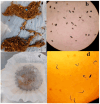Hydroalcoholic Extracts from Pleurotus ostreatus Spent Substrate with Nematocidal Activity against Nacobbus aberrans Phytonematode and the Non-Target Species Panagrellus redivivus
- PMID: 38999617
- PMCID: PMC11244132
- DOI: 10.3390/plants13131777
Hydroalcoholic Extracts from Pleurotus ostreatus Spent Substrate with Nematocidal Activity against Nacobbus aberrans Phytonematode and the Non-Target Species Panagrellus redivivus
Abstract
Pleurotus ostreatus, an edible mushroom widely consumed worldwide, generates a by-product known as spent mushroom substrate (SMS). This material has demonstrated biological activity against agricultural crop pathogens. In this study, we evaluated the nematocidal effectiveness of hydroalcoholic extracts (T5, T2, AT5, and AT2) derived from SMS of P. ostreatus against (J2) of the phytonematode Nacobbus aberrans and assessed their potential toxicity towards the non-target nematode Panagrellus redivivus. Among these extracts, AT5 exhibited the highest efficacy against N. aberrans and was the least toxic against P. redivivus. Liquid-liquid partitioning yielded the AQU fraction, which showed significant nematocidal activity against J2 (75.69% ± 8.99 mortality), comparable to chitosan. The GC-MS analysis revealed the presence of several compounds, including palmitic acid, linoleic acid, and 2,4-Di-tert-butylphenol. These findings are consistent with studies confirming the antagonistic effectiveness of these compounds against phytonematodes. Additionally, all extracts exhibited toxicity against P. redivivus, with T2 being the most toxic. Our findings demonstrate that while the AT5 extract displays antagonistic effectiveness against both N. aberrans and P. redivivus, it was the least toxic among the extracts tested. Thus, SMS of P. ostreatus holds potential as a source of nematocidal compounds, which could offer significant benefits for agricultural pest control.
Keywords: agro-industrial residues; bioactivity; myco-chemical; pest control.
Conflict of interest statement
The authors declare no conflicts of interest.
Figures




Similar articles
-
Nematocidal activity of hydroalcoholic extracts of spent substrate of Pleurotus djamor on L3 larvae of Haemonchus contortus.Vet Parasitol. 2021 Dec;300:109608. doi: 10.1016/j.vetpar.2021.109608. Epub 2021 Oct 27. Vet Parasitol. 2021. PMID: 34773769
-
Linking the protease activity to the nematicidal action of edible mushroom.World J Microbiol Biotechnol. 2024 Apr 17;40(6):170. doi: 10.1007/s11274-024-03980-6. World J Microbiol Biotechnol. 2024. PMID: 38630319
-
In vitro nematicidal activity of two ferrocenyl chalcones against larvae of Haemonchus contortus (L3) and Nacobbus aberrans (J2).J Helminthol. 2020 Sep 11;94:e190. doi: 10.1017/S0022149X2000070X. J Helminthol. 2020. PMID: 32912343
-
Modulation of the Gut Microbiota with Prebiotics and Antimicrobial Agents from Pleurotus ostreatus Mushroom.Foods. 2023 May 16;12(10):2010. doi: 10.3390/foods12102010. Foods. 2023. PMID: 37238827 Free PMC article. Review.
-
Pre- and Postharvest Strategies for Pleurotus ostreatus Mushroom in a Circular Economy Approach.Foods. 2024 May 9;13(10):1464. doi: 10.3390/foods13101464. Foods. 2024. PMID: 38790763 Free PMC article. Review.
References
-
- Niazi A.R., Ghafoor A. Different ways to exploit mushrooms: A Review. All Life. 2021;14:450–460. doi: 10.1080/26895293.2021.1919570. - DOI
-
- Royse D.J., Baars J., Tan Q. Current Overview of Mushroom Production in the World. In: Zied D.C., Pardo-Giménez A., editors. Edible and Medicinal Mushrooms Technology and Applications. John Wiley & Sons, Ltd.; Hoboken, NJ, USA: 2017. p. 455.
-
- Zied D.C., Sánchez J.E., Noble R., Pardo-Giménez A. Use of spent mushroom substrate in new mushroom crops to promote the transition towards a circular economy. Agronomy. 2020;10:1239. doi: 10.3390/agronomy10091239. - DOI
Grants and funding
LinkOut - more resources
Full Text Sources
Miscellaneous

